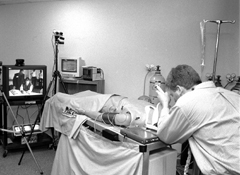The University Record, January 17, 2000 By Rebecca A. Doyle

Aboard a U.S. Navy ship on its way to engage in battle, Navy physicians flip on a pair of cameras and some lights, link their computers to a satellite and instantly learn firsthand how to treat a patient who has come in contact with an unusual nerve gas. They will be ready to treat the expected casualties.
In a rural hospital, a family practitioner broadcasts over an Internet2 connection a three-dimensional image of a patient who needs surgery that the doctor has never performed. A specialist at a large metropolitan hospital watches the 3D real-time image and advises from hundreds of miles away.
In a training barn, emergency medical technician trainees take turns learning the latest techniques for first-response trauma treatment by trying their hands at intubating a dummy—and their instructor, who sees everything they do and guides them through the procedure, is not even in the same city.
Technology and mechanics to make these scenarios happen has been available for some time, but it has never been put together in a package that allows physicians to experience the 3D image in a virtual reality setting without wearing goggles. That changed last week when Ethereal Technologies, the National Center for Manufacturing Sciences, the University of Michigan and Internet2 joined forces to experiment with all the technologies at two sites.
Navy Capt. Montgomery, at Old Dominion University in Norfolk, Virginia, played the expert in last week’s demonstration that simulated chest trauma. As he watched the image in a large bowl-like mirror, he stepped through emergency procedures for Chris Newton, house officer in surgery emergency medicine at the Health System.
The demonstration was a first-time try at using all of the pieces of the technology together, says Tim Pletcher, director of business information systems, Medical Center Information Technology. He stresses that the results were what anyone would expect from a “beta effort”—not quite perfect.
But the potential for use in medical trauma training—teaching medical students hands-on emergency procedures without causing additional trauma to either patient or student—is exciting, he notes.
Growing in part from the Department of Emergency Medicine’s Medical Readiness Trainer project, the collaboration on new virtual reality technology and Internet2 capabilities made the experiment possible, and puts future use of the technology a step closer.

